Recent Articles
Popular Makes
Body Types
2024 Nissan Ariya Road Test and Review
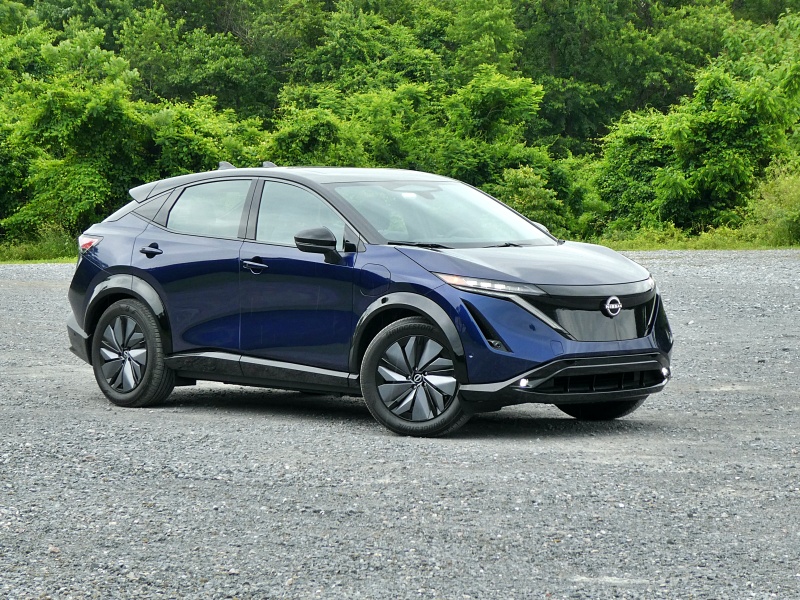
2024 Nissan Ariya Platinum+ ・ Photo by Brady Holt
Nissan didn’t build the world’s first electric car, but the 2011 Nissan Leaf was the first to be mass-produced and widely available. Its formula was to cover the price of an expensive electric battery by cutting costs elsewhere. The original Leaf was a small, slow, and simple, and it could travel just 73 miles on a charge. But the 2012 Tesla Model S upended how Nissan – and everyone else – thought about electric cars. By prioritizing performance, range, and style, and commanding a premium price for it, Tesla made EVs into a luxury good. And these days, Nissan wants in.
Price-conscious EV buyers still buy a few Leafs today (though now with a range of 149 to 212 miles). But Nissan is putting most of its electric attention into the 2024 Nissan Ariya, a flashy, luxuriously trimmed SUV. However, unlike back in 2011, Nissan is facing a wide array of competitors. In this review, we’re taking a look at how the Ariya fits into the bustling EV marketplace to see whether it’s the right way for you to go gas-free.
Now With a Price Cut
When the Ariya hit the market as an all-new 2023 model, it had a starting price of $43,190 and topped $60,000 with all-wheel drive, a bigger battery, and all the options. That’s not unreasonable for an upscale mid-size crossover SUV, but it proved too high for the segment.
So for 2024, Nissan cut the prices. The base Engage model now starts at $39,590 – only about $1,000 more than a similarly sized, similarly equipped Nissan Murano gas-powered crossover – and the top Ariya Platinum+ E-4ORCE is down to $54,190.
Nissan continues to let you pick and choose features, range, and speed out of a dizzying array of eight different trim levels. We’ll get to the powertrains soon, but know that even the Ariya Engage has leatherette upholstery, a power driver’s seat, heated front and rear seats, a heated steering wheel, a head-up display, GPS navigation, adaptive cruise control, and blind-spot monitoring. Upper trim levels let you add a panoramic moonroof, genuine leather, a power liftgate, ventilated front seats, a premium stereo, and a hands-free driving mode. Buyers of the Japanese-built Ariya don't qualify for a $7,500 federal tax credit like the Tesla Model Y and some other rivals, but as with all EVs, it does apply if you lease the vehicle.
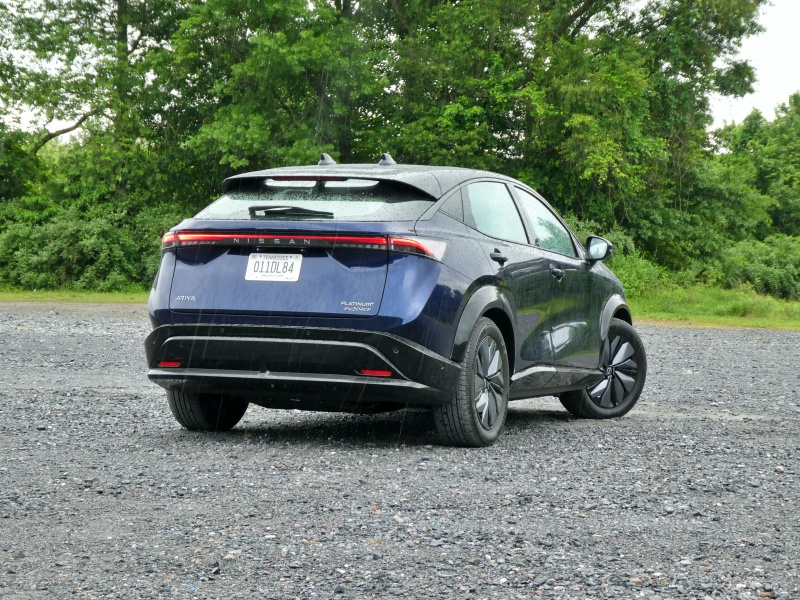
2024 Nissan Ariya Platinum+ ・ Photo by Brady Holt
Up to 304 Miles per Charge
The Ariya is sold with a choice of two batteries – one with a 63 kWh capacity and one with 87 kWh (which Nissan designates with a “+”). It also comes in a choice of front-wheel and all-wheel drive (which Nissan calls E-4ORCE). The weights and wheel sizes of different trim levels also affect its range.
If you’re interested in going as far as possible in an Ariya, you want the trim level called Venture+. Priced at $41,190, it includes front-wheel drive and the 87 kWh battery. And it keeps prices down by dropping a few features from the Engage, like heated leatherette upholstery. In EPA testing, the Ariya Venture+ travels 304 miles per charge and gets the energy equivalent of 103 miles per gallon. Other front-drive + trim levels dip to 289 miles per charge and 98 MPGe. The base Engage, meanwhile, uses the 63 kWh battery and goes just 216 miles per charge with front-wheel drive and 205 miles with all-wheel drive. That’s still more than enough for most Americans’ daily use with miles to spare, but it won’t be your pick if you’re interested in a road trip – especially because EVs typically achieve less range at highway speeds than around town.
AWD Ariyas with the bigger battery, like our test vehicle, get an EPA-estimated 257 to 272 miles per charge at 87 to 92 MPGe, depending on the trim level and wheel size. Our Platinum+ model, rated at 267 miles, was on pace to cover 274 miles in a mix of highway and city driving when we recharged it at 23% capacity.
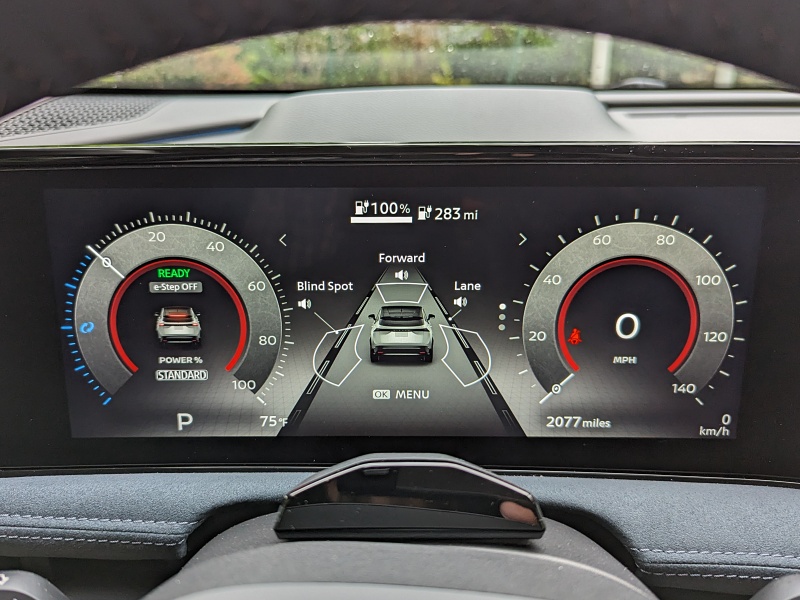
2024 Nissan Ariya Platinum+ ・ Photo by Brady Holt
Charge It Up
Charging the Ariya from empty takes 10.5 hours with the 62 kWh battery and 14 hours with 87 kWh using a 240-volt car charger, like you’d install at home or find in some public places. When you’re in a rush, a DC fast charger takes 35 minutes (or 40 minutes with the larger battery) to get you from 10 percent to 80 percent capacity. That’s not the fastest charging speed in the business, so if you plan frequent long trips, budget a few more minutes than a Tesla Model Y, Hyundai Ioniq 5, or Kia EV6.
Speaking of Tesla, later this year, the Ariya will be able to plug in at many Tesla Supercharger stations via a cable adapter – granting access to America’s best-regarded charging network. We also collected 4.5 miles of range per hour from a standard 120-volt outlet, which adds up if you're plugged in at home overnight.
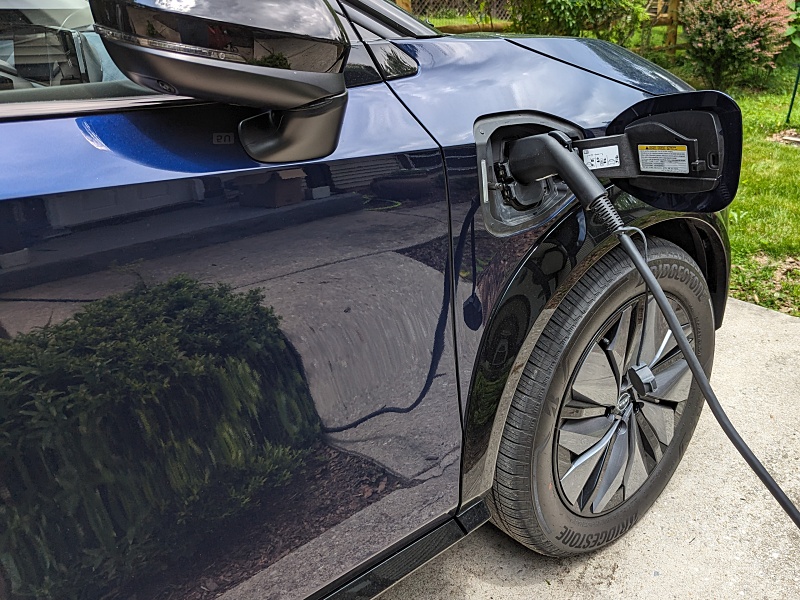
2024 Nissan Ariya Platinum+ ・ Photo by Brady Holt
Sleek Silhouette
Automakers have taken different approaches to their EVs – everything from futuristic transportation pods to ordinary cars that happen to be gas-free. Nissan tried the former with the first-generation Leaf and the latter with the current model that’s been on sale since 2018. The Ariya splits the difference.
At a glance, the Ariya is an upscale-looking, sleekly styled crossover SUV with a high windowline, small windows, and a coupe-like silhouette. From the rear, its shape, sharp creases, and slim taillights give us a European vibe. Yet up at the front, there’s a big black panel that has the shape of a grille yet which obviously doesn’t let in any air. (No engine, no need for airflow.) It stands out more on light-colored Ariyas than our dark blue test vehicle. It looks upscale without the high-performance vibe you might get from a Kia EV6 or Ford Mustang Mach E.
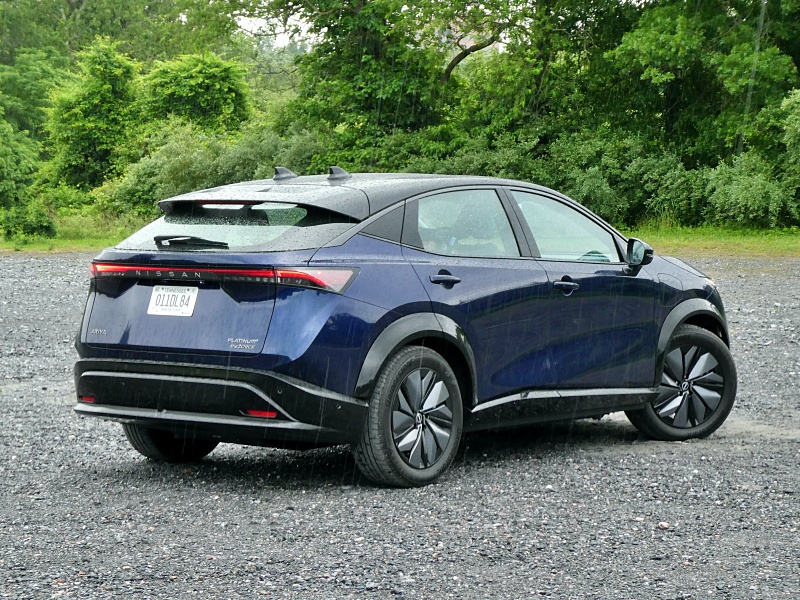
2024 Nissan Ariya Platinum+ ・ Photo by Brady Holt
Luxury-Grade Cabin
Tesla interiors are famously sterile, and many other EVs at this price point have followed suit. Nissan, by contrast, distinguishes the Ariya with a luxury-grade cabin. Sumptuous materials and well-honed moving parts help justify the Ariya’s price tag before you even consider it an EV; it’s a nicer cabin than you find in the Nissan Murano.
The Ariya has a simple dashboard that spans the cabin without a center stack that dips down to join the center console. It’s a clean, uncluttered look. A 12.3-inch digital gauge cluster sits behind the steering wheel, connected to a 12.3-inch infotainment touchscreen at the center of the dash. The infotainment system is Nissan’s standard issue, which means it’s easy to use without much pizzazz. And it supports Android Auto and Apple CarPlay smartphone integration. Compared with some EVs’ out-there interior details, we expect many buyers will appreciate the simplicity and let the Ariya’s interior materials handle the dazzle. The touch-sensitive buttons that hide flush in the dashboard’s wood trim require some extra concentration to tap, but they do clean up the interior style nicely. Plenty of cars achieve less of an effect with far worse controls. Seat heating and ventilation requires a careful tap on the touchscreen, though.
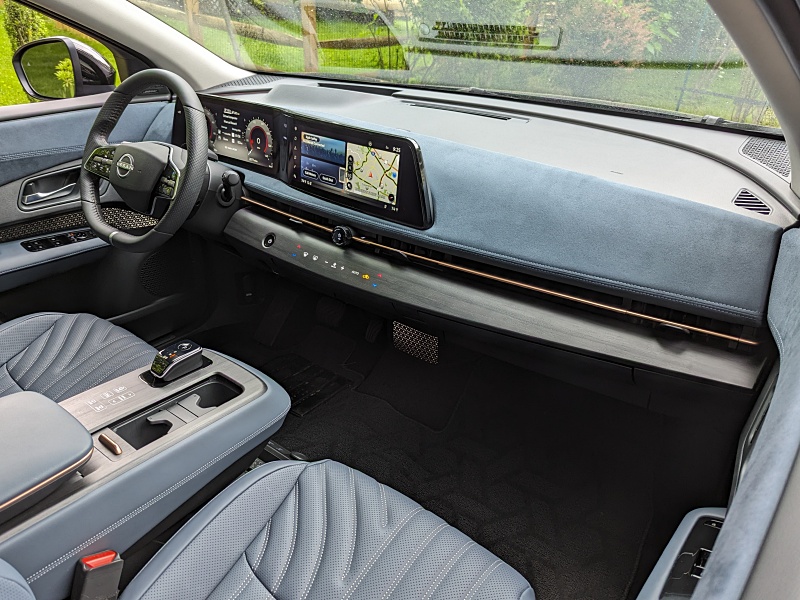
2024 Nissan Ariya Platinum+ ・ Photo by Brady Holt
Roomy and Comfortable
The Ariya’s luxury vibe continues to its spacious, comfortable seats. The driver sits high and enjoys a firm, supportive cushion. As we mentioned, heated front and rear seats and a heated steering wheel are included on all trim levels but the Venture+. That’s quite useful in an EV because it’s more efficient to warm a seat than use the electric heater to warm the entire cabin. On the same front, we wish that ventilated front seats were available on more than just the top-of-the-line Platinum+, though some rivals (including the best-selling Tesla Model Y) don’t offer them at all.
The Ariya’s backseat is comfortable, too. Rear passengers get acres of legroom, and the sporty-looking roofline doesn’t rob head space. There is an impact on cargo, though, as we’ll discuss in a moment.
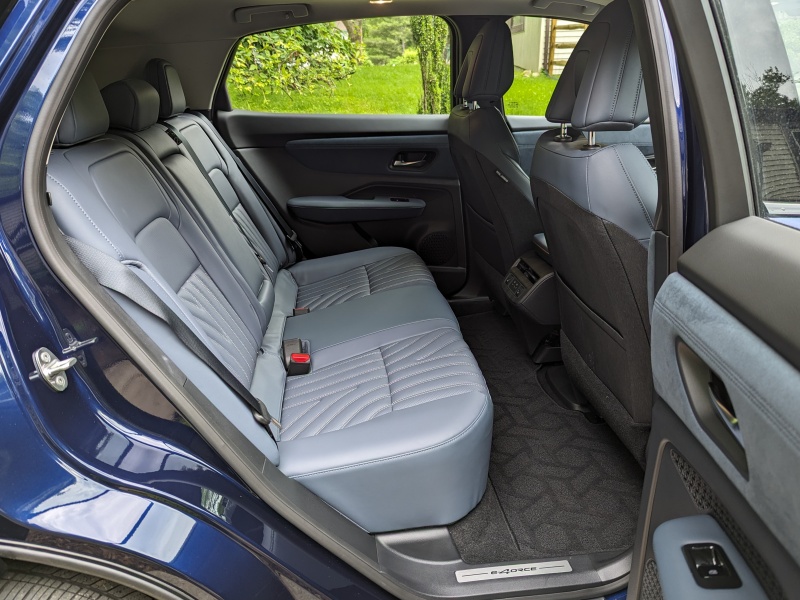
2024 Nissan Ariya Platinum+ ・ Photo by Brady Holt
OK Space for Your Stuff
The Ariya is a mid-size crossover with nearly identical dimensions to a Hyundai Ioniq 5. That makes it smaller than a Tesla Model Y, and the roofline cuts into cargo space behind the rear seat.
By the numbers, the Ariya has 22.8 cubic feet of space behind the rear seat – less than a subcompact Nissan Kicks crossover, and about 5 to 7 cubic feet shy of an Ioniq 5 or Model Y. Still, there’s a decent amount of floor space, and the cargo floor is adjustable. You can have a higher floor with hidden storage underneath, which is level with the folded rear seatbacks. Alternatively, you can lower the floor for the largest possible open space. Total cargo space with the rear seat folded matches the Ioniq 5 at 59.7 cubic feet, though the Model Y has 76 cubic feet of total volume. Nissan doesn’t provide a front trunk, or “frunk,” but the Ariya is rated to tow a small 1,500-pound trailer.
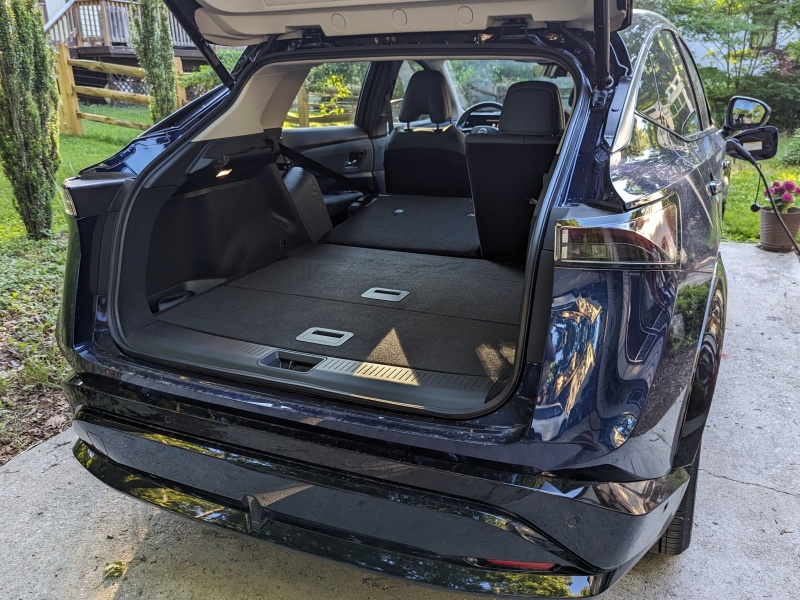
2024 Nissan Ariya Platinum+ ・ Photo by Brady Holt
Easy to Drive
Some EVs, including the best-selling Tesla, are built as performance vehicles. That means speedy acceleration, agile handling, and sometimes-bumpy rides. Nissan takes a more relaxed approach to the Ariya.
Front-drive Ariyas make 214 to 238 horsepower depending on the battery size and need about 7 seconds to reach 60 mph. That’s decently quick for an SUV – especially considering that you don’t hear the sound of an engine laboring – but nothing incredible. AWD models, with an extra electric motor, make a mightier 335 to 389 hp that cuts the 0-60 sprint to around 5 seconds. That’s sports-car fast but only about average among the Ariya’s high-speed peers. However, while the ride isn’t quite as smooth as a Toyota bZ4X or Subaru Solterra, it’s more comfortable and quiet than a Tesla or most other competitors. And it’s not clumsy, inspiring confidence in routine driving, though it loses its poise if you push harder around a tight curve. Plus, upper-trim Ariyas have an upgraded hands-free adaptive cruise control; Nissan invites you to take your hands off the wheel while you stay in your lane on the freeway.
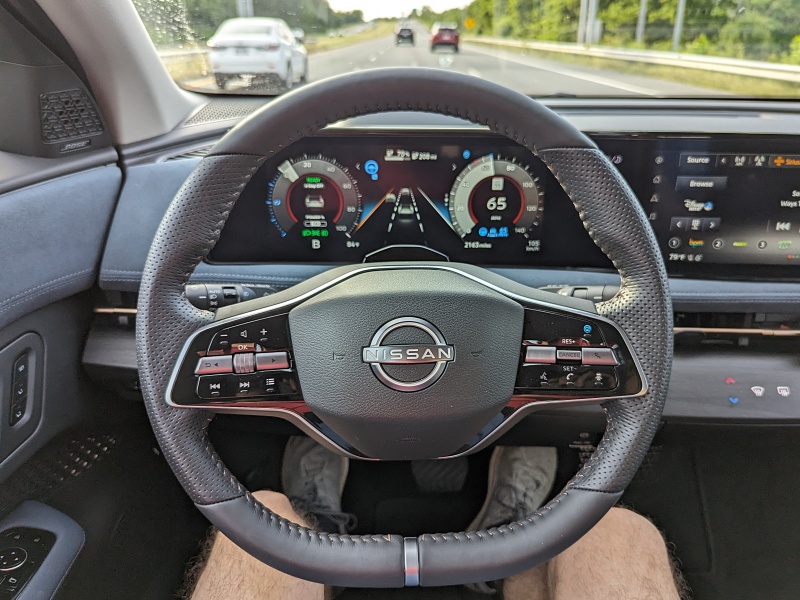
2024 Nissan Ariya Platinum+ ・ Photo by Brady Holt
Plenty of Competition
As we’ve mentioned, the Ariya faces plenty of competition. The Tesla Model Y is the natural benchmark, and as we’ve mentioned, the Ariya is more conventionally luxurious and easier to use than the Tesla – with a richer interior, smoother and quieter ride, and simpler controls, including Apple CarPlay and Android Auto. It also has a longer list of available high-end features. However, the Tesla is quicker, goes farther on a charge, and has more space, all for less money.
We’d also shop the Ariya against the Kia EV6 and Hyundai Ioniq 5, two EV cousins with similar bones and different styles. The 2024 Ariya now costs a bit less than these competitors and has a fancier interior, but they charge faster, accelerate faster, and have more cargo space. The Toyota bZ4X and Subaru Solterra – two EV cousins with the same bones and near-identical style – are mild-mannered, comfortable ways to go electric, but they cost more than the Ariya and have shorter ranges per charge. The Volkswagen ID.4 is a value-focused rival when you factor in its $7,500 federal tax credit; it’s nothing fancy like the Ariya, but it’s functional and easy to drive except for a lousy control layout. Lastly, two all-new models can be worth consideration: the Chevrolet Blazer EV and its Honda Prologue cousin. They offer compelling value when you factor in their $7,500 tax credits, and their ranges beat the Ariya’s. But the Nissan is quicker, and only the Honda has Android Auto or Apple CarPlay.
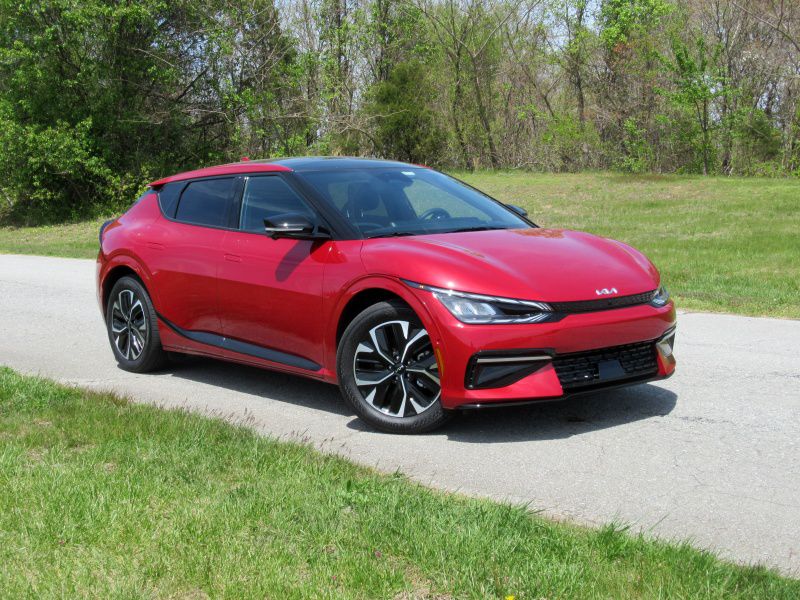
2022 Kia EV6 ・ Photo by Brady Holt
The More Affordable Luxury EV
When we tally up the Ariya’s pros and cons against the Tesla Model Y, we’re not surprised that the latter is more popular. But the 2024 Nissan Ariya has a lot to offer, too.
It’s no high-tech marvel, without the gee-whiz speed or advanced infotainment of a Tesla or the ultra-fast charging of a Hyundai or Kia. But it works well as an electric car, yet it’s also a stylish and upscale regular SUV. And with this year’s price cut, it’s an even more tempting way than ever to get a high-end feel while going gas-free.
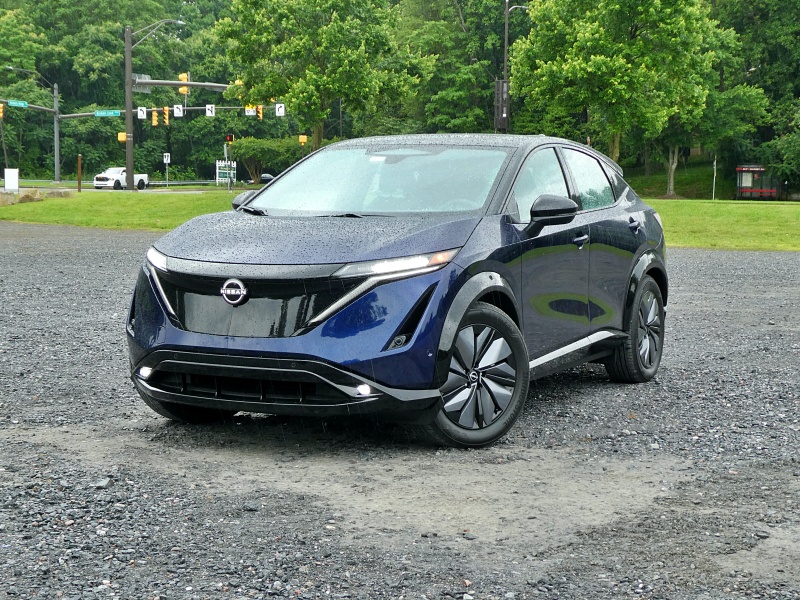
2024 Nissan Ariya Platinum+ ・ Photo by Brady Holt